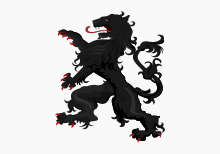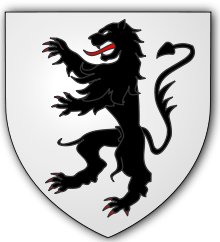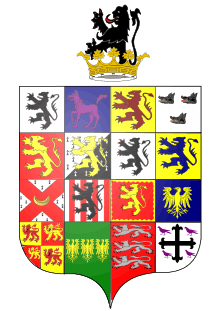Powys Fadog
Powys Fadog (English: Lower Powys or Madog's Powys) was the northern portion of the former princely realm of Powys, which split in two following the death of Madog ap Maredudd in 1160. The realm was divided under Welsh law, with Madog's nephew Owain Cyfeiliog inheriting the south (see Powys Wenwynwyn) and his son Gruffydd Maelor I, who inherited the north.
Principality of Powys Fadog Tywysogaeth Powys Fadog | |||||||||
|---|---|---|---|---|---|---|---|---|---|
| 1160–1277 | |||||||||
 Banner of Powys Fadog, known as the Black Lion of Powys
 Coat of Arms of Powys Fadog
| |||||||||
Powys as divided in 1190. | |||||||||
| Capital | Dinas Brân and Glyndyfrdwy | ||||||||
| Common languages | Middle Welsh | ||||||||
| Government | Monarchy | ||||||||
• 1160–1191 | Gruffydd Maelor I | ||||||||
• 1191–1236 | Madog ap Gruffydd Maelor | ||||||||
• 1236–1269 | Gruffydd II | ||||||||
• 1269–1277 | Madog II | ||||||||
| Historical era | Middle Ages | ||||||||
• Established | 1160 | ||||||||
• Conquered and dismantled by England | 1277 | ||||||||
| |||||||||
| Today part of | |||||||||
^ Powys Fadog was often known in English as Lower Powys | |||||||||
Gruffydd received the cantref of Maelor and the commote of Iâl as his portion and later added Nanheudwy, Cynllaith, Glyndyfrdwy and Mochnant Is Rhaeadr. This northern realm became known as Powys Fadog after the accession of his son Madog ap Gruffudd in 1191 who reigned until 1236, and after whom it may be named (see alternative translations above). During his reign, Madog initially adopted a neutral position between Gwynedd and England but by 1215 had settled on an alliance with Llywelyn ab Iorwerth of Gwynedd. This policy of alliance with Gwynedd continued under his successor Gruffudd II over his thirty-three year reign (1236-1269). This alliance was formalised when Powys Fadog became vassal of Llywelyn ap Gruffudd in his role as Prince of Wales under the terms of the Treaty of Montgomery in 1267.
When Gruffydd II died in 1269, his eldest son Madog II succeeded to the throne but the small portion of the realm awarded to his younger brothers caused rebellion in which England became malevolently engaged. By 1276 Powys Fadog was in disorder with brother fighting brother, and this conflagration soon became a small part in the campaign being waged by the English Crown against the fragile Welsh confederation.
In early 1277 an army led by the Earl of Warwick with support from the treacherous brother of Llywelyn ap Gruffudd, Dafydd ap Gruffydd, marched from Chester into Powys Fadog. Madog II was compelled to submit and under the terms of his surrender the realm would be divided between himself and his younger brother Llywelyn. The royal centre at Castell Dinas Brân, widely considered the strongest native castle in all Wales, was to be had by neither and dismantled.
It appears that Madog II (or at least men loyal to him) remained at Dinas Brân for some time after this accord because the Earl of Lincoln commanded an English force to take the castle on 10 May 1277. Before they could complete their encirclement of the royal centre they learnt that the small garrison inside had abandoned the cause and burnt the castle. Madog II was forced to flee to the protection of Gwynedd. He was killed in battle while campaigning alongside Llywelyn ap Gruffudd later that same year. The castle of Dinas Brân would be reduced, the dramatic ruins of which may still be seen today.
His surviving brothers Llywelyn Fychan and Gruffudd Fychan I accepted the overlordship of England and the realm was divided between them. Special provision was also made for the two sons of Madog II. However, in 1282, during the final campaign of Llywelyn ap Gruffudd, all of the rulers of Powys Fadog would once again turn against England in a final conflict during which Llywelyn ap Gruffudd, Llywelyn Fychan and the two sons of Madog II would die.
Under the terms of the Statute of Rhuddlan in 1284 all of the remaining former princely titles and territories in Wales were abolished. Gruffydd Fychan (the brother of Madog II and last heir to the throne of Powys Fadog) was pardoned but reduced in status to that of a minor local noble or uchelwyr. His direct descendant, Owain Glyndŵr, would become the leader of a later Welsh rebellion in 1400.
The territory of Powys Fadog was broken up into a series of lordships based on the former cantrefi. Under the Laws of Wales Acts these marcher lordships were merged with other adjacent lands formerly part of Gwynedd and incorporated into new administrative counties; the cantrefi of Maelor, Nanheudwy, Iâl, Cynllaith and Mochnant Is Rhaeadr going to Denbighshire and Maelor Saesneg forming the Wrexham exclave of Flintshire. This situation was maintained until the re-organisation of local government in Wales in 1974.
Princes of Powys Fadog and later Lords of Glyn Dyfrdwy
- 1160–1191 Gruffydd Maelor
- 1191–1236 Madog ap Gruffydd Maelor
- 1236–1269 Gruffydd II ap Madog, Lord of Dinas Brân
- 1269–1277 Madog II ap Gruffydd, Lord of Dinas Brân
- 1277–1289 Gruffydd Fychan I ap Gruffydd
- 1289–1304 Madog Crypl, Lord of Glyndyfrdwy and Lord of Cynllaith Owain
- 1304–c.1343 Gruffydd of Rhuddalt, Lord of Glyndyfrdwy and Lord of Cynllaith Owain
- c.1343–1369 Gruffydd Fychan II, Lord of Glyndyfrdwy and Lord of Cynllaith Owain
- 1369–c.1416 Owain ap Gruffydd, Lord of Glyndyfrdwy and Lord of Cynllaith Owain
Owain ap Gruffydd rose in revolt against the English crown in 1400 and proclaimed himself Prince of Wales. He became more widely known as Owain Glyndŵr. After his death at least one of his sons survived him, along with a younger brother styled the Lord of Gwyddelwern.
- 1416–c.1421? Maredudd ab Owain Glyndŵr
Progeny of the Princely House

Direct patrilineal descendants of Owain Brogyntyn (fl. 1180) the youngest son of Madog ap Maredudd were the hereditary lords of Edeirnion who during the 12th and 13th-centuries usually ruled as subjects of the prince of Gwynedd, whose homage was bought by the princes of Powys Fadog. This cadet branch of the House of Mathrafal survived the purges which eradicated most of the Welsh royalty in the 13th and 15th centuries. Proven descendants of his were listed in Burke's Peerage & Gentry in the late 19th century as hereditary barons of Cymmer yn Edeirnion and Jones of Faerdref Uchaf have survived into the modern era.
References
- Jacob Youde William Lloyd, The history of the princes, the lords marcher, and the ancient nobility of Powys Fadog, and the ancient lords of Arwystli, Cedewen, and Meirionydd
- J. Beverley-Smith, Llywelyn ap Gruffudd, Prince of Wales (1998)
- http://www.sewellgenealogy.com/p70.htm#i5288
- https://web.archive.org/web/20080709045952/http://freespace.virgin.net/owston.tj/walesprinces.htm
- http://www.maximiliangenealogy.co.uk/burke1/Royal%20Descents/hughesofgwerclas_1.htm